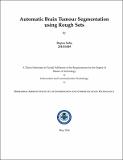Please use this identifier to cite or link to this item:
http://drsr.daiict.ac.in//handle/123456789/634| Title: | Automatic brain tumour segmentation using rough sets |
| Authors: | Mitra, Suman K. Saha, Rupsa |
| Keywords: | Brain Tumour Segmentation Automatic Segmentation Rough Sets quadtree partitioning |
| Issue Date: | 2016 |
| Publisher: | Dhirubhai Ambani Institute of Information and Communication Technology |
| Citation: | Saha, Rupsa (2016). Automatic brain tumour segmentation using rough sets. Dhirubhai Ambani Institute of Information and Communication Technology, x, 51p. (Acc.No: T00597) |
| Abstract: | Brain tumour segmentation is an important research topic in computer assistedmedical intervention. Automation of this process ensures that valuable expertresources are made available to a wider range of people and more number of patientscan avail of timely and effective treatment.Automatic segmentation of brain tumours from Magnetic Resonance images is achallenging task due to the wide variation in intensity, size, location of tumoursin images. Defining a precise boundary for a tumour is essential for correct diagnosisand subsequent treatment of patients.Rough set theory, an extension of classical set theory, deals with the vaguenessof data by attempting to determine the boundary region of a set. The lower approximation(confirmed regions of interest) and the upper approximation (lowercombined with probable regions of interest) are determined with the help of rulesdefined on the attributes of the data available to us. The more discriminative attributesavailable, the better the rules that can the generated which lead to thedifference between the lower and upper approximation being smaller, i.e. the setbecoming less "rough".The aim of this work is to explore the possibility and effectiveness of using arough set model to represent the tumour regions in MR images accurately, withQuadtree partitioning and simple K-means as precursors to indicate and limit thepossible relevant regions. The advantage of using rough sets lie in its ability torepresent the impreciseness of set boundaries, which is one of the major challengesfaced in tumour segmentation.The Brain Tumour Segmentation Challenge is organized yearly and the trainingdata provided by them consists of Magnetic Resonance Images of multiple subjectsin four different modes, viz. T1, T2, contrast enhanced T1 and FLAIR. Thedifferent modes are the sources of different kinds of information which are requiredto understand details about the tumour pathology. Experiments are carriedout on the BRATS 2013 and 2015 databases and results are comparable tothose reported by recent works. |
| URI: | http://drsr.daiict.ac.in/handle/123456789/634 |
| Appears in Collections: | M Tech Dissertations |
Files in This Item:
| File | Description | Size | Format | |
|---|---|---|---|---|
| 201411049.pdf Restricted Access | 2.97 MB | Adobe PDF |  View/Open Request a copy |
Items in DSpace are protected by copyright, with all rights reserved, unless otherwise indicated.
